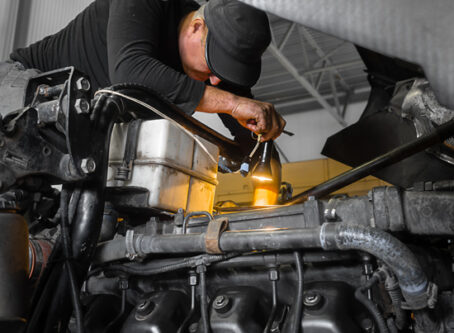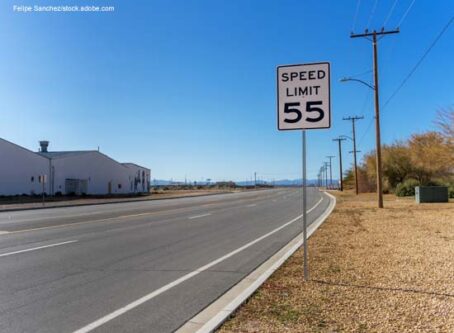States consider speed limit revisions
Speed limit rule changes continue to be a topic of consideration at statehouses, with at least a half dozen states considering legislation to make revisions.
The Owner-Operator Independent Drivers Association believes roadways are safest when all vehicles are allowed to travel at the same rate of speed. The Association does not advocate for a specific speed limit.
Indiana
Indiana is one of only a few states that continue to hold onto a speed limit differential for cars and trucks.
Statute allows cars to travel 70 mph on the state’s fastest roadways, while vehicles in excess of 26,000 pounds are limited to 65 mph.
On an annual basis at the statehouse, legislation is pursued to get rid of the speed limit differential for cars and trucks on rural stretches of interstate and on the Indiana Toll Road.
Rep. Mike Aylesworth, R-Hebron, was once again behind a pursuit to eliminate speed differentials. His bill received consideration in the House Roads and Transportation Committee, but HB1055 did not come up for a vote. As a result, the bill died in committee.
Supporters of uniform speed limits contend the Hoosier State is long overdue to make the change. They point out that if everyone is flowing at the same speed, traffic moves better.
The Indiana Motor Truck Association has been consistent through the years in its opposition to the rule change. A year ago, Robert Haag, IMTA chairman, told legislators it is important to resist the urge to drive faster. He added that trucking operations would not adjust equipped speed limiters.
Inaction on the issue at the statehouse is despite testimony provided by the Indiana Department of Transportation.
IDOT’s Andrea Zimmerman communicated to the panel information about a joint research study on speed limits by the agency and Purdue University. The study suggested uniform 70 mph speed limits would reduce crash frequencies in the state by about 20%.
OOIDA believes that speed differentials are based on a flawed belief that slower trucks equal safer trucks. Doug Morris, OOIDA director of safety and security operations, said that is simply not the case.
He added that a rule revision is needed in Indiana “to correct a law that is flawed in nature and does nothing to improve highway safety.”
Maryland
Meanwhile in Maryland, a bill halfway through the statehouse would revise speed limit rules.
House lawmakers voted 110-27 to advance a bill that would authorize the Maryland State Highway Administration to decrease the maximum speed limits by 5 mph on urban state highways. A traffic or engineering study would not be necessary to make the change.
Delegate Ken Kerr, D-Frederick, told a House committee his bill would apply to state-owned and -maintained highways that do not restrict non-motorized access and where highways are located in incorporated municipalities. The bill would also apply to locations identified by the U.S. Census Bureau Designated Urban Areas where pedestrians walk adjacent to highways.
The Maryland Department of Transportation said HB278 would allow the State Highway Administration to respond in a more agile manner to areas where speed is a contributor to roadway incidents.
The bill’s next move is to Senate Judicial Proceedings.
Michigan
In Michigan, The Senate Transportation and Infrastructure Committee voted to advance a bill that is intended to address “flaws” in how the state sets local roadway speed limits.
Michigan law states that an engineering and safety study must be conducted to modify a speed limit. Additionally, speeds on state and local roads must be rounded up to the nearest multiple of 5 mph of the 85th percentile standard.
Sponsored by Rep. Bradley Slagh, R-Zeeland, HB4012 would update how the state observes the 85th percentile speed rule – the speed at or below which 85% of vehicles travel in free-flowing traffic.
Specifically, the state would be given flexibility to round down the 85th percentile speed when necessary. Local officials could set the speed to any multiple of 5 mph within 5 mph of the 85th percentile.
Slagh has used the example of the 85th percentile speed on a roadway with an average speed of 37.6 mph. His bill would give the state flexibility to set the speed at 35 mph, instead of requiring an increase to 40 mph.
He said legislation also would remove the requirement for an engineering and safety study to be conducted to alter a speed limit. Instead, a modified speed limit could be determined in accordance with traffic engineering practices that provide “an objective analysis of the characteristics of the highway.”
Additionally, the speed limit would be permitted to be set below the 85th percentile if an engineering and safety study showed a situation with hazards to public safety that is not reflected by the 85th percentile speed. A speed limit could not be set below the 50th percentile speed.
House lawmakers approved the bill in October. HB4012 awaits further consideration on the Senate floor. If approved there, it would move to the governor’s desk.
New Jersey
The 85th percentile formula is also the topic of a New Jersey Senate bill.
Sponsored by Sen. Declan O’Scanlon, R-Monmouth, S1652 would use the formula to set speed limits on limited access highways that include the New Jersey Turnpike and Garden State Parkway.
If approved, the New Jersey Department of Transportation and other state traffic agencies would be able to use 85th percentile studies to set speed limits.
O’Scanlon said adopting the formula is a better option for setting speed limits than relying on politicians and officials to make the correct decision.
He added that the change would result in “the smoothest, safest level of traffic flow and inflict the least amount of arbitrary punishment on people behaving reasonably.”
S1652 is in the Senate Transportation Committee.
New York
The speed limit for cars and trucks is the topic of identical New York bills.
The state permits all vehicles to travel 65 mph on interstate highways and other limited access roads.
Bills in the Assembly and Senate would authorize 70 mph speeds for all vehicles. Specifically, the state DOT and the New York Thruway Authority would be permitted to implement the change.
Sen. Tom O’Mara, R-Big Flats, wrote in a bill memo that the change would keep New York in line with maximum speeds in many other states.
“The majority of states across the country have state speed limits that exceed 65 mph,” O’Mara wrote. “New York has failed to keep up with the rest of the country by not adopting a more efficient speed limit.
He said his bill “would correct this inefficacy by allowing for a 70 mph speed limit where appropriate.”
S2209 and A5044 are in their respective transportation committees.
Oklahoma
In Oklahoma, one House bill covers speed limits on the state’s fastest roadways.
Speed limits on rural interstate highways are set at 75 mph. Oklahoma turnpikes have speeds set at 80 mph. The maximum speed limits apply to all vehicles.
Sponsored by Rep. Ross Ford, R-Broken Arrow, HB3894 would implement a 65 mph minimum speed limit for the affected controlled-access highways. LL









